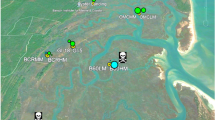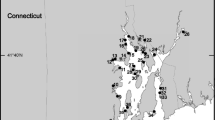Abstract
A positive relationship between interannual sea level and plant growth is thought to stabilize many coastal landforms responding to accelerating rates of sea level rise. Numerical models of delta growth, tidal channel network evolution, and ecosystem resilience incorporate a hump-shaped relationship between inundation and plant primary production, where vegetation growth increases with sea level up to an optimum water depth or inundation frequency. In contrast, we use decade-long measurements of Spartina alterniflora biomass in seven coastal Virginia (USA) marshes to demonstrate that interannual sea level is rarely a primary determinant of vegetation growth. Although we find tepid support for a hump-shaped relationship between aboveground production and inundation when marshes of different elevation are considered, our results suggest that marshes high in the intertidal zone and low in relief are unresponsive to sea level fluctuations. We suggest existing models are unable to capture the behavior of wetlands in these portions of the landscape, and may underestimate their vulnerability to sea level rise because sea level rise will not be accompanied by enhanced plant growth and resultant sediment accumulation.



Similar content being viewed by others
References
Alberti J, Casariego AM, Daleo P, Fanjul E, Silliman B, Bertness M, Iribarne O. 2010. Abiotic stress mediates top-down and bottom-up control in a Southwestern Atlantic salt marsh. Oecologia 163:181–91.
Anthony EJ. 2004. Sediment dynamics and morphological stability of estuarine mangrove swamps in Sherbro Bay, West Africa. Mar Geol 208:207–24.
Blum LK, Christian RR. 2004. Belowground production and decomposition along a tidal gradient in a Virginia salt marsh. In: Fagherazzi S, Marani M, Blum LK, Eds. The ecogeomorphology of tidal marshes. Washington, DC: American Geophysical Union.
Cahoon DR, Reed DJ. 1995. Relationships among marsh surface topography, hydroperiod, and soil accretion in a deteriorating Louisiana salt marsh. J Coast Res 11:357–69.
Cahoon DR, Hensel P, Rybczyk J, McKee KL, Proffitt CE, Perez BC. 2003. Mass tree mortality leads to mangrove peat collapse at Bay Islands, Honduras after Hurricane Mitch. J Ecol 91:1093–105.
Chalmers AG. 1982. Soil dynamics and the productivity of Spartina alterniflora. In: Kennedy VS, Ed. Estuarine comparisons. New York: Academic Press. p 231–42.
Christian RR, Stasavich L, Thomas C, Brinson MM. 2000. Reference is a moving target in sea-level controlled wetlands. In Weinstein MP, Kreeger DA, Eds. Concepts and controversies in tidal marsh ecology. Dordrecht: Kluwer Press. pp 805–25.
Christiansen, T. 1998. Sediment deposition on a tidal salt marsh. PhD Dissertation, University of Virginia, Charlottesville.
Christiansen T, Wiberg PL, Milligan TG. 2000. Flow and sediment transport on a tidal salt marsh surface. Estuar Coast Shelf Sci 50:315–31.
D’Alpaos A, Lanzoni S, Marani M, Rinaldo A. 2007. Landscape evolution in tidal embayments: modeling the interplay of erosion, sedimentation, and vegetation dynamics. J Geophys Res 112:F01008.
D’Alpaos D, Lanzoni S, Mudd SM, Fagherazzi S. 2006. Modeling the influence of hydroperiod and vegetation on the cross-sectional formation of tidal channels. Estuar Coast Shelf Sci 69:311–24.
DeLaune RD, Nyman JA, Patrick WH. 1994. Peat collapse, ponding, and wetland loss in a rapidly submerging coastal marsh. J Coast Res 10:1021–30.
De Leeuw J, Olff H, Bakker JP. 1990. Year-to-year variation in peak above-ground biomass of six salt-marsh angiosperm communities as related to rainfall deficit and inundation frequency. Aquat Bot 36:139–51.
Erwin RM, Cahoon DR, Prosser DJ, Sanders GM, Hensel P. 2006. Surface elevation dynamics in vegetated Spartina marshes versus unvegetated tidal ponds along the mid-Atlantic coast, USA, with implications to waterbirds. Estuar Coast 29:96–106.
Fagherazzi S, Kirwan ML, Mudd SM, Guntenspergen GR, Temmerman S, D’Alpaos A, van de Koppel J, Craft C, Rybczyk J, Reyes E, Clough J. 2011. Numerical models of salt marsh evolution: ecological, geomorphic and climatic factors. Rev Geophys. doi:10.1029/2011RG000359.
Friedrichs CT, Perry JE. 2001. Tidal salt marsh morphodynamics: a synthesis. J Coast Res 27:7–37.
Hensel PF, Scott GA, Allen AL, Gill SK, Cahoon DR, Nemerson D, Guntenspergen GR. 2008. Geodetic and tidal datums: tying wetland surface elevation change to local water levels. 2008 Ocean Sciences Meeting Abstract. Orlando (FL): American Geophysical Union.
Hughes ZJ, FitzGerald DM, Wilson CA, Pennings SC, Wieski K, Mahadevan A. 2009. Rapid headward erosion of marsh creeks in response to relative sea level rise. Geophys Res Lett 36:L03602. doi:10.1029/2008GL036000.
Kirwan ML, Guntenspergen GR, Morris JT. 2009. Latitudinal trends in Spartina alterniflora productivity and the response of coastal marshes to global change. Glob Change Biol 15:1982–9.
Kirwan ML, Murray AB. 2007. A coupled geomorphic and ecological model of tidal marsh evolution. Proc Natl Acad Sci USA 104:6118–22.
Kirwan ML, Murray AB, Boyd WS. 2008. Temporary vegetation disturbance as an explanation for permanent loss of tidal wetlands. Geophys Res Lett 35:L05403. doi:10.1029/2007GL032681.
Kirwan ML, Guntenspergen GR, D’Alpaos A, Morris JT, Mudd SM, Temmerman S. 2010. Limits on the adaptability of coastal marshes to rising sea level. Geophys Res Lett 37:L23401. doi:10.1029/2010GL045489.
Larsen LG, Harvey JW. 2010. How vegetation and sediment transport feedbacks drive landscape change in the Everglades and wetlands worldwide. Am Nat 176:E66–79.
Lorenzo-Trueba J, Voller VR, Paola C, Twilley RR. 2010. Toward a model framework for sedimentary delta growth that accounts for biological processes. Abstract B33D-0427, AGU Fall Meeting, San Francisco.
Marani M, D’Alpaos A, Lanzoni S, Carniello L, Rinaldo A. 2007. Biologically-controlled multiple equilibria of tidal landforms and the fate of the Venice lagoon. Geophys Res Lett 34:L11402. doi:10.1029/2007GL030178.
Marion C, Anthony EJ, Trentesaux A. 2009. Short-term (≤2 yrs) estuarine mudflat and saltmarsh sedimentation: high-resolution data from ultrasonic altimetry, rod surface-elevation table, and filter traps. Estuar Coast Shelf Sci 83:475–84.
Mariotti G, Fagherazzi S. 2010. A numerical model for the coupled long-term evolution of salt marshes and tidal flats. J Geophys Res 115:F01004. doi:10.1029/2009JF001326.
McKee KL, Patrick WH Jr. 1988. The relationship of smooth cordgrass (Spartina alterniflora) to tidal datums: a review. Estuaries 11:143–51.
Mendelssohn IA, Morris JT. 2000. Eco-physiological controls on the productivity of Spartina alterniflora Loisel. In Weinstein MP, Kreeger DA, Eds. Concepts and controversies in tidal marsh ecology. Dordrecht: Kluwer Press. pp. 805–25.
Morris JT, Haskins B. 1990. A 5-yr record of aerial primary production and stand characteristics of Spartina alterniflora. Ecology 71:2209–17.
Morris JT, Sundareshwar PV, Nietch CT, Kjerfve B, Cahoon DR. 2002. Responses of coastal wetlands to rising sea level. Ecology 83:2869–77.
Mudd SM, Fagherazzi S, Morris JT, Furbish DJ. 2004. Flow, sedimentation, and biomass production on a vegetated salt marsh in South Carolina: toward a predictive model of marsh morphologic and ecologic evolution. In: Fagherazzi S, Marani A, Blum LK, Eds. The ecogeomorphology of tidal marshes. Coastal and estuarine monograph series. Washington, DC: American Geophysical Union. pp. 165–87.
Nicholls RJ and others. 2007. Coastal systems and low-lying areas. In: Climate change 2007: impacts, adaptation and vulnerability. Contribution of Working Group II to the Fourth Assessment Report of the Intergovernmental Panel on Climate Change. Cambridge: Cambridge University Press.
Odum EP, Finn JT, Franz EH. 1979. Perturbation theory and the subsidy-stress gradient. Bioscience 29:349–52.
Osgood DT, Zieman JC. 1998. The influence of subsurface hydrology on nutrient supply and smooth cordgrass (Spartina alternifloa) production in a developing barrier island mash. Estuaries 21:767–83.
Paramor OAL, Hughes RG. 2004. The effects of bioturbation and herbivory by the polychaete Nereis diversicolor on loss of saltmarsh in south-east England. J Appl Ecol 41:449–63.
Smith SM. 2009. Multi-decadal changes in salt marshes of Cape Cod, MA: photographic analyses of vegetation loss, species shifts, and geomorphic change. Northeast Nat 16:183–208.
Steever EZ, Warren RS, Niering WA. 1976. Tidal energy subsidy and standing crop production of Spartina alterniflora. Estuar Coast Mar Sci 4:473–8.
Teal JM, Howes BL. 1996. Interannual variability of a saltmarsh ecosystem. Limnol Oceanogr 41:802–9.
Ursino N, Silvestri S, Marani M. 2004. Subsurface flow and vegetation patterns in tidal environments. Water Resour Res 40:W05115. doi:10.1029/2003WR002702.
Van de Koppel J, van der Wal D, Bakker JP, Herman PMJ. 2005. Self-organization and vegetation collapse in salt marsh ecosystems. Am Nat 165:E1–12.
Visser JM, Sasser CE, Cade BS. 2006. The effect of multiple stressors on salt marsh end-of-season biomass. Estuar Coast 29:328–39.
Acknowledgments
Access to the study area was provided by The Nature Conservancy. Funding was provided through the Virginia Coast Reserve Long-Term Ecological Research program (NSF DEB-0621014) and the U.S. Geological Survey Global Change Research Program.
Author information
Authors and Affiliations
Corresponding author
Additional information
Author Contributions
RRC, LKB, and MMB designed and performed the field research. MLK analyzed the data, contributed new methods, and wrote the article. RRC and LKB contributed to writing.
Rights and permissions
About this article
Cite this article
Kirwan, M.L., Christian, R.R., Blum, L.K. et al. On the Relationship Between Sea Level and Spartina alterniflora Production. Ecosystems 15, 140–147 (2012). https://doi.org/10.1007/s10021-011-9498-7
Received:
Accepted:
Published:
Issue Date:
DOI: https://doi.org/10.1007/s10021-011-9498-7




